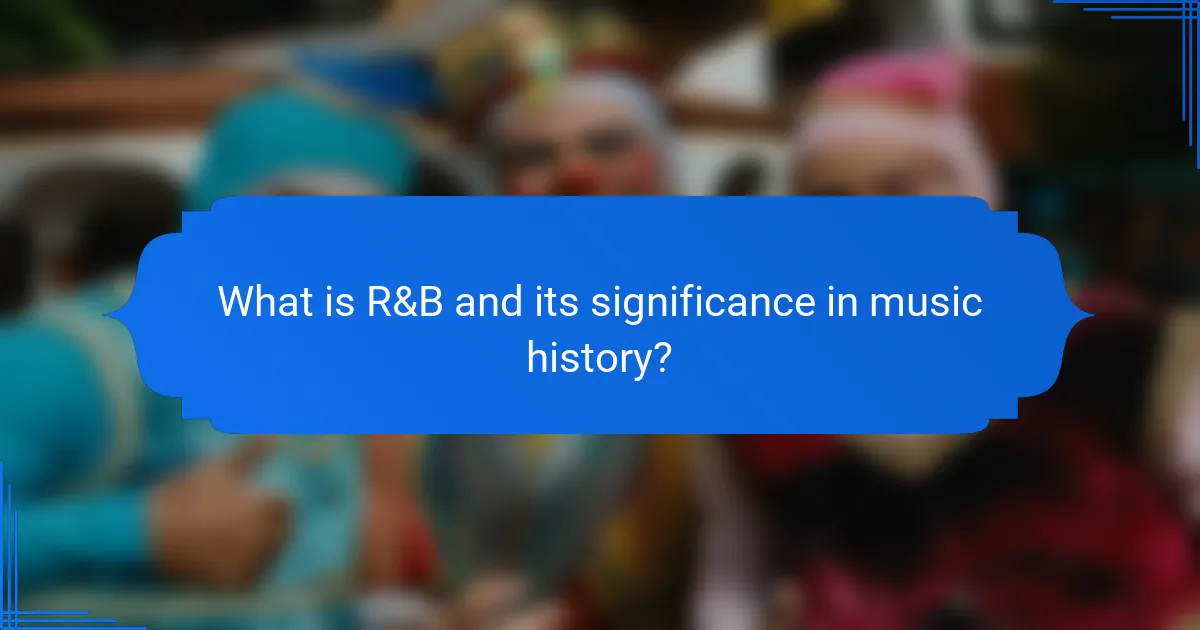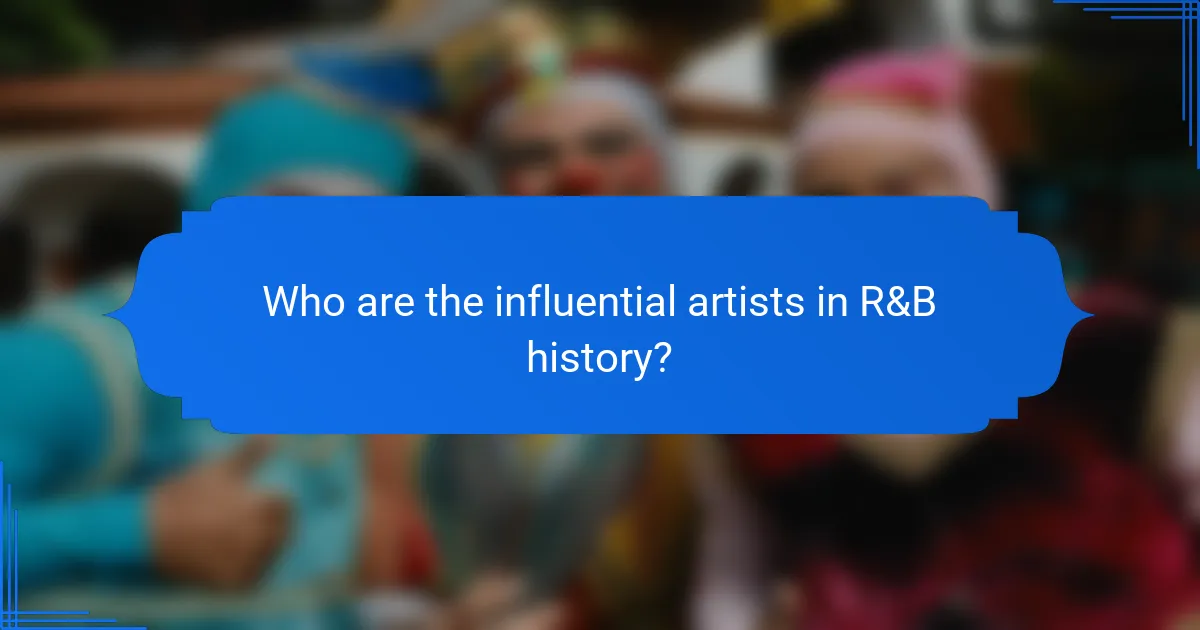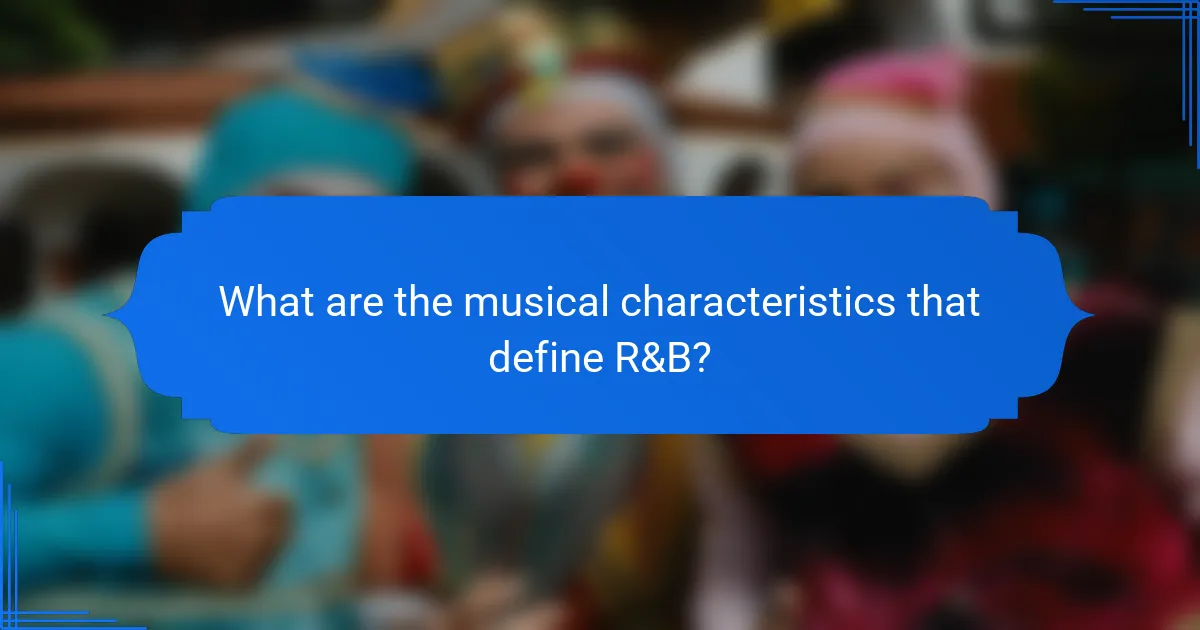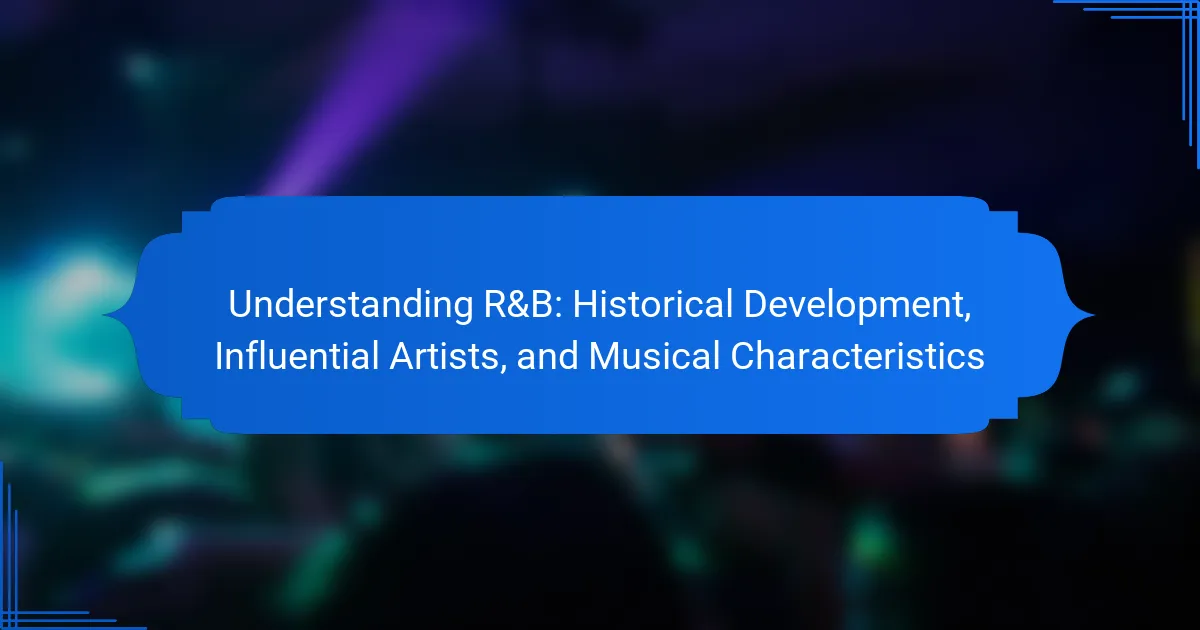Rhythm and Blues (R&B) is a popular music genre that emerged in the African American community during the 1940s, characterized by its blend of jazz, gospel, and blues elements. This article examines the historical development of R&B, highlighting influential artists such as Ray Charles, Aretha Franklin, and Marvin Gaye, who have shaped the genre’s evolution. It also explores the musical characteristics of R&B, including its strong rhythms, emotive vocal delivery, and thematic focus on love and social issues. Additionally, the article discusses the genre’s impact on modern pop music and its transformation into contemporary R&B, integrating hip-hop and electronic influences.

What is R&B and its significance in music history?
R&B, or Rhythm and Blues, is a genre of popular music that originated in the African American community in the 1940s. It combines elements of jazz, gospel, and blues, creating a distinctive sound characterized by strong rhythms and emotional vocal delivery. R&B played a crucial role in the development of rock and roll in the 1950s. Artists like Ray Charles and Ruth Brown were pivotal in popularizing the genre. The term “R&B” has evolved over the decades, now encompassing various styles, including contemporary R&B, which incorporates hip-hop and electronic elements. R&B has significantly influenced many other genres, shaping the sound of modern pop music. Its legacy is evident in the works of artists like Beyoncé and Usher, who draw on R&B traditions while pushing the genre forward.
How did R&B evolve over the decades?
R&B evolved significantly from the 1940s to the 2020s. In the 1940s, rhythm and blues emerged as a blend of jazz, gospel, and blues. Artists like Ray Charles and Ruth Brown popularized this genre. By the 1960s, Motown Records brought a polished sound to R&B, featuring artists like Marvin Gaye and The Supremes. The 1970s introduced funk influences, with artists like Earth, Wind & Fire and Parliament. In the 1980s, synthesizers and electronic elements became prominent, showcased by artists like Prince and Whitney Houston. The 1990s saw the rise of new jack swing, combining R&B with hip-hop, led by artists like Bobby Brown and TLC. In the 2000s and beyond, contemporary R&B incorporated elements of hip-hop and pop, with artists like Beyoncé and Usher leading the way. This evolution reflects changing musical trends and cultural influences over the decades.
What are the key historical milestones in the development of R&B?
The key historical milestones in the development of R&B include the genre’s origins in the 1940s. Rhythm and blues emerged from African American musical traditions, combining jazz, gospel, and blues elements. In 1949, the term “rhythm and blues” replaced “race music” in Billboard magazine, marking a significant shift in marketing and cultural perception. The 1950s saw artists like Ray Charles and Ruth Brown popularizing R&B, bringing it into mainstream music. The 1960s introduced Motown, with artists like Marvin Gaye and The Supremes, further expanding the genre’s reach. In the 1970s, funk influences began to shape R&B, with artists like Stevie Wonder and Earth, Wind & Fire. The 1980s and 1990s saw the rise of new jack swing, blending R&B with hip-hop, led by artists like Bobby Brown and Janet Jackson. Today, R&B continues to evolve, incorporating elements of pop, hip-hop, and electronic music, reflecting its dynamic history and cultural significance.
How did social and cultural factors influence the evolution of R&B?
Social and cultural factors significantly influenced the evolution of R&B. The genre emerged from the African American experience in the 1940s and 1950s. Social movements, such as the Civil Rights Movement, shaped its themes of love, struggle, and resilience. Cultural influences included blues, jazz, and gospel, which provided a musical foundation. The migration of African Americans to urban areas also impacted R&B’s sound and style. This urbanization led to a blend of regional styles, creating a more diverse musical landscape. Additionally, the rise of radio and television helped popularize R&B, reaching wider audiences. The genre’s evolution reflects the changing social dynamics and cultural expressions of its time.
What are the foundational characteristics of R&B music?
R&B music is characterized by its blend of rhythm and blues elements. It typically features strong backbeats and a focus on vocal performance. The genre often incorporates elements from jazz, gospel, and soul music. Instrumentation commonly includes bass, drums, keyboards, and horns. Lyrically, R&B songs often explore themes of love, relationships, and emotional experiences. The use of call-and-response patterns is also prevalent. R&B has evolved through various eras, influencing and being influenced by other genres like hip-hop and pop. Historical examples include artists like Ray Charles and Aretha Franklin, who helped define the sound.
What elements define the R&B sound?
The R&B sound is defined by its combination of rhythm, blues, and soul influences. Key elements include smooth vocal delivery, often featuring melismatic singing techniques. Instrumentation typically involves electric guitars, bass, keyboards, and drums. The genre emphasizes groove and rhythm, creating a danceable quality. Lyrically, R&B often explores themes of love, relationships, and emotional experiences. The sound also incorporates elements of jazz and funk, enhancing its complexity. Historically, R&B emerged in the 1940s, evolving from earlier blues and jazz styles. Influential artists like Ray Charles and Aretha Franklin helped shape its distinctive sound.
How do rhythm and blues differentiate from other genres?
Rhythm and blues (R&B) differentiate from other genres primarily through its unique blend of jazz, gospel, and blues influences. R&B typically features strong backbeats and expressive vocal styles. The genre emphasizes emotional themes, often focusing on love and relationships. Instrumentation in R&B often includes electric guitars, bass, drums, and keyboards. Unlike rock music, R&B prioritizes groove and rhythm over heavy guitar riffs. Furthermore, R&B artists frequently employ call-and-response vocal techniques, rooted in African American musical traditions. The genre has evolved to incorporate elements of hip-hop and pop, making it distinct from traditional blues and soul. Notable R&B artists, such as Ray Charles and Aretha Franklin, have shaped its development, showcasing its rich history.

Who are the influential artists in R&B history?
Influential artists in R&B history include Ray Charles, Aretha Franklin, and Marvin Gaye. Ray Charles is often called the “Father of Soul” for blending R&B with gospel and blues. Aretha Franklin, known as the “Queen of Soul,” brought emotional depth and power to the genre. Marvin Gaye’s work in the 1970s, especially with “What’s Going On,” addressed social issues and showcased R&B’s versatility. Other notable artists include Stevie Wonder, whose innovative sound and songwriting have had a lasting impact. Whitney Houston redefined R&B with her vocal prowess and crossover appeal in the 1980s and 1990s. These artists have shaped R&B’s evolution and continue to influence contemporary musicians.
What impact did early R&B artists have on the genre?
Early R&B artists significantly shaped the genre by blending various musical styles. They incorporated elements of jazz, blues, and gospel into their music. This fusion created a distinct sound that appealed to a wide audience. Artists like Ray Charles and Ruth Brown were pivotal in this development. Their works laid the groundwork for future genres, including rock and roll and soul. The rhythmic and melodic innovations introduced by these artists influenced countless musicians. Additionally, their success helped to pave the way for African American artists in mainstream music. This legacy continues to resonate in contemporary R&B today.
Who are the pioneering figures in R&B and what are their contributions?
Ray Charles is a pioneering figure in R&B. He blended gospel, blues, and jazz into a new sound. His hit songs like “What’d I Say” and “Georgia on My Mind” showcased this fusion. Charles was instrumental in popularizing R&B in the 1950s.
Aretha Franklin is another key figure in R&B. She brought powerful vocals and emotional depth to the genre. Her songs, including “Respect” and “Natural Woman,” became anthems for civil rights. Franklin’s influence extended beyond music into social activism.
James Brown is often called the “Godfather of Soul.” His energetic performances and innovative rhythms shaped R&B’s evolution. Brown’s hits like “Papa’s Got a Brand New Bag” introduced funk elements to R&B. His work laid the foundation for future genres like hip-hop.
Sam Cooke was known for his smooth voice and songwriting talent. His song “A Change Is Gonna Come” became a civil rights anthem. Cooke’s ability to blend pop and soul made him a significant figure in R&B history.
These artists collectively transformed R&B, making it a vital part of American music culture. Their contributions continue to influence artists today.
How did these artists shape the future of R&B music?
These artists shaped the future of R&B music by innovating its sound and expanding its reach. They incorporated various musical styles, such as hip-hop, jazz, and electronic music, creating new sub-genres. Their lyrical content often addressed social issues, personal struggles, and love, resonating with a broader audience. Artists like Prince and Whitney Houston pushed vocal techniques and performance styles to new heights. Their influence led to the emergence of contemporary R&B, which blends traditional elements with modern production. The commercial success of these artists paved the way for future talents in the genre. Their collaborations with producers and songwriters set new industry standards. Overall, their contributions have left a lasting impact on the evolution of R&B music.
Which contemporary artists are shaping R&B today?
Contemporary artists shaping R&B today include H.E.R., Khalid, and SZA. H.E.R. is known for her soulful voice and songwriting skills. She has won multiple Grammy Awards, showcasing her impact on the genre. Khalid’s unique sound blends R&B with pop and electronic elements. His debut album, “American Teen,” received critical acclaim and commercial success. SZA’s album “Ctrl” has been influential, addressing themes of love and self-identity. Each of these artists brings a fresh perspective to R&B, contributing to its evolution in the modern music landscape.
What styles and innovations are modern R&B artists introducing?
Modern R&B artists are introducing styles such as trap soul, neo-soul, and alternative R&B. These genres blend traditional R&B with hip-hop elements, creating a fresh sound. Artists like SZA and Khalid exemplify this innovation. They incorporate diverse influences from electronic, jazz, and pop music. This fusion results in unique rhythms and melodic structures. Additionally, modern R&B often features introspective lyrics that address personal and social issues. The production techniques have evolved, utilizing digital tools for layering and sound design. This evolution reflects a broader trend in contemporary music towards genre-blending and experimentation.
How do current artists pay homage to the roots of R&B?
Current artists pay homage to the roots of R&B by incorporating classic elements into their music. They often sample iconic R&B tracks, which connects modern sounds to historical influences. Many artists also use traditional instrumentation, such as horns and strings, reminiscent of classic R&B arrangements. Lyrically, they frequently explore themes of love and heartbreak, similar to those found in early R&B songs. Collaborations with veteran R&B artists further bridge the generational gap. Additionally, current artists may adopt vocal styles and techniques that echo the greats of the genre. Live performances often feature choreography and staging that reflect the history of R&B. This blend of old and new keeps the essence of R&B alive in contemporary music.

What are the musical characteristics that define R&B?
R&B is characterized by its blend of soul, funk, jazz, and gospel influences. It often features smooth vocal styles and emotive lyrics. Rhythm and blues typically utilizes a strong backbeat, often emphasized by drums. The genre frequently incorporates syncopated bass lines, enhancing its groove. Instrumentation includes electric guitars, keyboards, and brass sections. Harmony in R&B often employs seventh chords and extended chord progressions. Melodic structures are usually catchy and memorable, often focusing on vocal improvisation. R&B also emphasizes themes of love, heartbreak, and social issues in its lyrics.
How do instrumentation and arrangement contribute to R&B music?
Instrumentation and arrangement are crucial elements in R&B music. They define the genre’s unique sound and emotional depth. Instrumentation typically includes instruments like electric guitars, bass, drums, and keyboards. These instruments create a rich harmonic and rhythmic foundation.
The arrangement dictates how these instruments interact and the overall structure of the song. It influences dynamics, layering, and the balance between melody and harmony. For example, a prominent bass line often drives the groove in R&B tracks.
Additionally, the use of horns and strings can add a lush quality. This contributes to the genre’s emotive and soulful character. Historical examples include the incorporation of orchestral elements in Motown hits. This showcases how arrangement shapes listener experience.
Ultimately, both instrumentation and arrangement are essential in crafting the signature sound of R&B music.
What role do vocals play in the R&B genre?
Vocals are central to the R&B genre. They convey emotion and storytelling, which are essential elements of R&B music. The vocal delivery often includes techniques like melisma and vocal runs. These techniques enhance expressiveness and showcase the singer’s skill. R&B vocals are characterized by their soulful quality and rich timbre. Historically, artists like Aretha Franklin and Marvin Gaye exemplified this vocal style. Their performances highlighted the emotional depth that vocals can bring to the genre. R&B vocals also play a crucial role in creating a connection with the audience. The genre often emphasizes themes of love, heartbreak, and social issues through its lyrics and vocal interpretations.
How does lyrical content reflect the themes of R&B?
Lyrical content in R&B reflects themes of love, heartbreak, and emotional vulnerability. These themes resonate deeply with listeners, creating a personal connection. R&B lyrics often explore complex relationships and intimate feelings. They frequently address issues like longing, desire, and reconciliation. Notably, artists like Marvin Gaye and Whitney Houston exemplify these themes in their work. Their songs often depict personal stories that evoke strong emotions. The genre’s focus on storytelling enhances its relatability. This lyrical approach has been a defining characteristic of R&B since its inception.
What are the sub-genres and variations within R&B?
R&B has several sub-genres and variations. These include contemporary R&B, which blends soul, funk, and hip-hop influences. Neo-soul emphasizes emotional depth and live instrumentation. Alternative R&B incorporates experimental sounds and diverse musical styles. Classic R&B refers to the genre’s roots in the 1940s and 1950s. Smooth jazz R&B combines jazz elements with traditional R&B. Soul, often considered a precursor, focuses on gospel and blues influences. Funky R&B emphasizes rhythmic grooves and danceable beats. Each sub-genre showcases unique attributes while maintaining the core essence of R&B.
What distinguishes contemporary R&B from traditional R&B?
Contemporary R&B differs from traditional R&B primarily through its incorporation of modern production techniques and diverse musical influences. Traditional R&B, rooted in the 1940s and 1950s, features a focus on rhythm and blues with a strong emphasis on vocal performance and instrumental backing. In contrast, contemporary R&B blends elements from hip-hop, pop, and electronic music. This fusion results in a more varied sound palette and often includes the use of synthesizers and digital effects.
Additionally, lyrical themes in contemporary R&B frequently explore personal and social issues in a more explicit manner. Traditional R&B lyrics often focus on love and relationships within a more straightforward context. The evolution in instrumentation and production techniques, such as the use of auto-tune and sampling, further distinguishes contemporary R&B from its predecessor.
Notable artists like Beyoncé and The Weeknd exemplify this modern approach, showcasing versatility and genre-blending in their music. The Billboard charts reflect this shift, as contemporary R&B consistently incorporates trends from other genres, making it more commercially viable today.
How do influences from hip-hop and pop shape modern R&B?
Hip-hop and pop significantly shape modern R&B by introducing rhythmic complexity and diverse production techniques. Hip-hop’s influence is evident in the incorporation of beats and flows, which enhance the genre’s rhythmic appeal. Popular artists like Drake and Beyoncé blend R&B with hip-hop elements, creating crossover hits. This fusion attracts a broader audience and expands the genre’s reach. Additionally, pop’s melodic structures and catchy hooks enhance R&B’s accessibility. Collaborations between R&B and pop artists often yield chart-topping singles, illustrating this synergy. The evolution of digital production tools, often rooted in hip-hop, allows for innovative soundscapes in modern R&B. These influences collectively redefine the genre, making it more versatile and relevant in today’s music landscape.
What are some practical tips for exploring R&B music?
To explore R&B music, start by listening to classic albums from influential artists. Important figures include Ray Charles, Aretha Franklin, and Marvin Gaye. Next, create playlists that feature both classic and contemporary R&B tracks. This helps in understanding the evolution of the genre. Attend live performances or R&B concerts to experience the music in a vibrant setting. Follow R&B-focused music blogs and podcasts for recommendations and insights. Join online communities or forums dedicated to R&B to engage with other fans. Finally, explore subgenres like neo-soul and contemporary R&B to broaden your understanding.
How can listeners discover classic and modern R&B artists?
Listeners can discover classic and modern R&B artists through various platforms and methods. Streaming services like Spotify and Apple Music offer curated playlists that feature both classic and contemporary R&B tracks. These playlists often include popular songs and hidden gems. Social media platforms, such as Instagram and TikTok, allow fans to follow artists and discover new music through recommendations and viral trends. Music blogs and websites frequently highlight emerging R&B artists and provide reviews of their work. Additionally, attending live music events and festivals can expose listeners to a range of R&B performances. Radio stations dedicated to R&B music also play a mix of classic and modern tracks, helping listeners explore different eras of the genre.
What playlists or resources are recommended for R&B enthusiasts?
Popular playlists for R&B enthusiasts include “R&B Classics” and “Today’s R&B Hits.” These playlists feature influential artists and contemporary tracks that define the genre. Resources such as Spotify, Apple Music, and YouTube provide extensive collections of R&B music. Additionally, blogs like “Okayplayer” and “The Boar” offer insights and recommendations on new R&B artists and albums. These platforms regularly update their selections to reflect current trends in R&B music.
The main entity of the article is R&B, or Rhythm and Blues, a genre of popular music that originated in the African American community in the 1940s. The article provides a comprehensive overview of R&B’s historical development, highlighting key milestones and influential artists such as Ray Charles, Aretha Franklin, and Marvin Gaye. It explores the genre’s evolution over the decades, its foundational characteristics, and the impact of social and cultural factors on its sound. Additionally, the article examines contemporary artists shaping R&B today and discusses the musical elements that define the genre, including instrumentation, vocal techniques, and lyrical themes.
